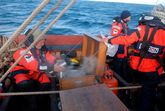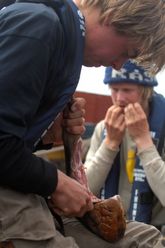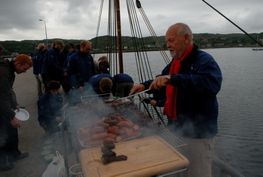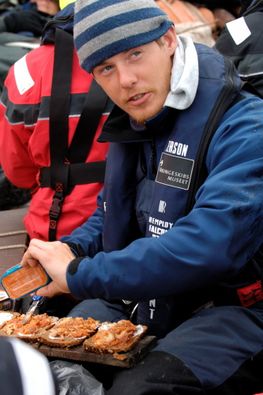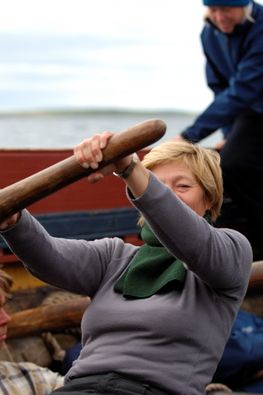Cook
On board the Sea Stallion the ship's cook is called a hovmester, or steward. The ship has two cooks, and they share the many tasks between them. Prior to the Sea Stallion's first voyage to Norway in 2006 the stewards were responsible for organising the galley (kitchen) on board. They had to find out how to stow the cooking utensils and to cook on board, buy kitchen equipment and find room for provisions and water below deck.
The galley consists of two wooden boxes at the stern of the ship. One contains two gas rings, which allow the stewards – in contrast to the Viking cooks – to cook while the ship is sailing. The other box contains kitchen utensils such as pots and pans, a chopping board and knives as well as spices and oil.
Prior to the different expeditions, the stewards plan the meals afew days a head - often 10 - 12 days - and buy the necessary provisions as well as food with good keeping qualities like canned goods, pasta, rice and dried meat. Due to lack of space the stewards also have to shop en route during the voyage.
The stewards have a provision group, consisting of a man from each of the ship's rooms (sections). The group supplies ideas for the meals, helps devising a plan for stowing the galley as well as purchasing the supplies and preparing the meals.
En route, the provision group is responsible for distributing the food on board – and also for finding men to do jobs in the galley (kabystjans)and peggy (bakstørn). Kabystjans is performed before the meal and consists of helping the cooks. Bakstørn involves washing up after the meal.
The diet
The diet is nourishing just like it was in the Viking Age. The men must feel full and satisfied and be able to keep warm so that they have the necessary energy for the hard work on board. A good, healthy diet can also prevent illness among the crew.
The fare on board the Sea Stallion is somewhat different from that eaten by the Vikings a thousand years ago.
Today, the crew are given a much more varied diet with greater quantities of vegetables and fruit.
- Breakfast: Each morning the crew is served a breakfast of hot porridge and coffee or tea. It is important to have something warm to start the day on after a long and perhaps cold night of sailing. On the voyage to Dublin the crew ate almost five tons of porridge.
- Lunch: consists of ordinary sandwiches. Each section of 10-12 men shares two lunch boxes with rye bread, butter and meat/fish of good keeping quality, such as tinned tuna, tinned mackerel in tomato sauce and smoked salami.
Supper, however, varies according to the weather and the location of the ship.
- At harbour: A barbecue or dishes with fresh produce, like vegetables. Often local specialities are used.
- When sailing in calm conditions: The stewards are able to serve a hot meal; soup, stews, boiled sausages or Spagetti Bolognese – i.e. meals that are easy to cook in large portions in one or two large pots.
- In rough weather: The ship is very unstable and it is dangerous to light the gas rings and have pots filled with hot food. Dried and smoked meat and smoked sausages that can be eaten with a slice of bread is then served. Freeze-dried foods, which only require the addition of some water is also a pert of the menu. These are given to the crew if cooking is impossible.
The Night box
In addition to all this, each section has a night box containing tea, coffee, chocolate, biscuits, apples and nuts, serving as a store for the night watchmen. Night service can be hard because the men are tired. They use a lot of energy keeping warm and is in need of hot drinks and sugar to keep their energy and spirits up.
Beverages
The crew on board the Sea Stallion drink water like the Vikings did on board their warships. Beer and spirits are completely prohibited for safety reasons. Water is stowed below deck in large containers; these are filled up each time the ship docks. Last year, on the trip to Norway, the water consumption on the voyage was in average 3 litres per person per day.
Fact: There is no refrigerator on board, so the food brought on the voyage has to have long keeping qualities.
By: Louise Kæmpe Henriksen
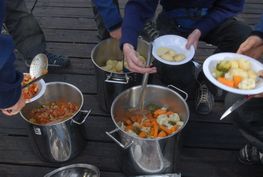
Did you know:
That when sailing to Dublin the crew ate and drank
- 1000 chocolate bars
- 500 kg of pouridge
- 5124 litres of water
